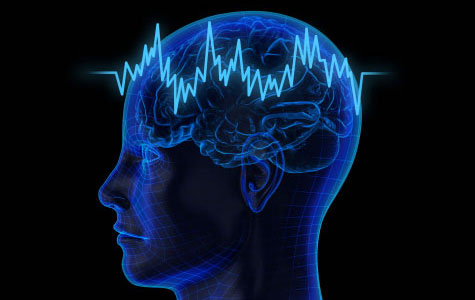Biofeedback is a technology that, in a clinical setting is used to monitor muscle contractions and relaxation levels of individuals wishing to undo perpetual states of tension that feed chronic pain or hypertension states. Biofeedback was originally developed as a result of Herbert Benson’s Harvard University study of hypertension. Herbert and his colleagues were successful in teaching squirrel monkeys to raise their blood pressure using willpower alone in return for edible rewards. Equipment used in these experiments were instrumental in the development of biofeedback. The experiments went well for Dr. Benson and the human race since the link between hypertension and stress was proven, but the same can’t be said for the poor monkeys who, kept in a state of hypertension, died from renal complications and cardiovascular problems.
In my anxiety research work at York University, I utilize state of the art software to graphically illustrate to research participants their current level of relaxation and teach them vital skills which are proven to assist the physical release of tension and ultimately reduce stress and help break any tension experienced as a result. Using diagrammatic representations of stress and tension delivered to software via non-invasive Biofeedback sensors, I am able to decrease the relaxation learning curve and help our nursing students rapidly master some very deep levels of relaxation. The sensors are able to measure skin conductance levels (SCL) and heart rate variability (HRV) which are affected by brain activity, blood pressure, and muscle tension, all excellent indicators of one’s homeostasis. Homeostasis is the ideal state of a relaxed person biologically functioning at the healthiest levels of biochemical being. Defined by American physiologist, Walter B. Cannon in the early nineteen hundreds, homeostasis is derived from the Greek words “homoios”, meaning similar and “stasis”, meaning position. From this description, homeostasis may be considered as one’s ability to stay the same since roughly translated it means: Staying Power.
It is well documented that a person’s lifestyle has a serious impact on their life expectancy. Learning how to effectively undo the effects of stress leads to higher levels of stress resilience and significantly assists our bodies to cope with the unavoidable stress of life. Under stress or duress, chemical balance and the resulting tension state described in Dr. Hans Selye’s 1936 definition of a “general adaptation syndrome” (G.A.S.), better known as “Biological Stress Syndrome” are responsible for arming an individual for action – fight-or-flight. An evolutionary necessity (we would not have survived as a species without it), the stress response ultimately works to wear down a person’s immune system and other vital processes if not resolved.
In addition to physiological and biochemical alterations that accompany stress, a significant breakdown in cognitive processes, digestive efficiency, fertility and even sexual appetite are all typical ramifications of a stressful situation or state of being. Perpetual tension and chronic stress are incredibly harmful and predictably result in a breakdown of a person’s system efficiency which leads to a host of avoidable medical complications of both a physical and psychological nature. Regardless of any medically prescribed treatments, the ability to trigger a relaxation response that effectively counters the stress response is a vital skill that, once learned will continue to benefit healing and recovery exponentially. From this perspective, anyone wishing to optimize their life expectancy, enhance creativity or excel in any activity stands to benefit from Biofeedback, unfortunately most people wait until they have a painful problem before they seek to balance their biological self.
Now that you know how the ability to access a deep, healthy state of relaxation can help you, maybe it is finally time to do something about it?

 dfdsfs
dfdsfs
 dfdsfs
dfdsfs
Comments